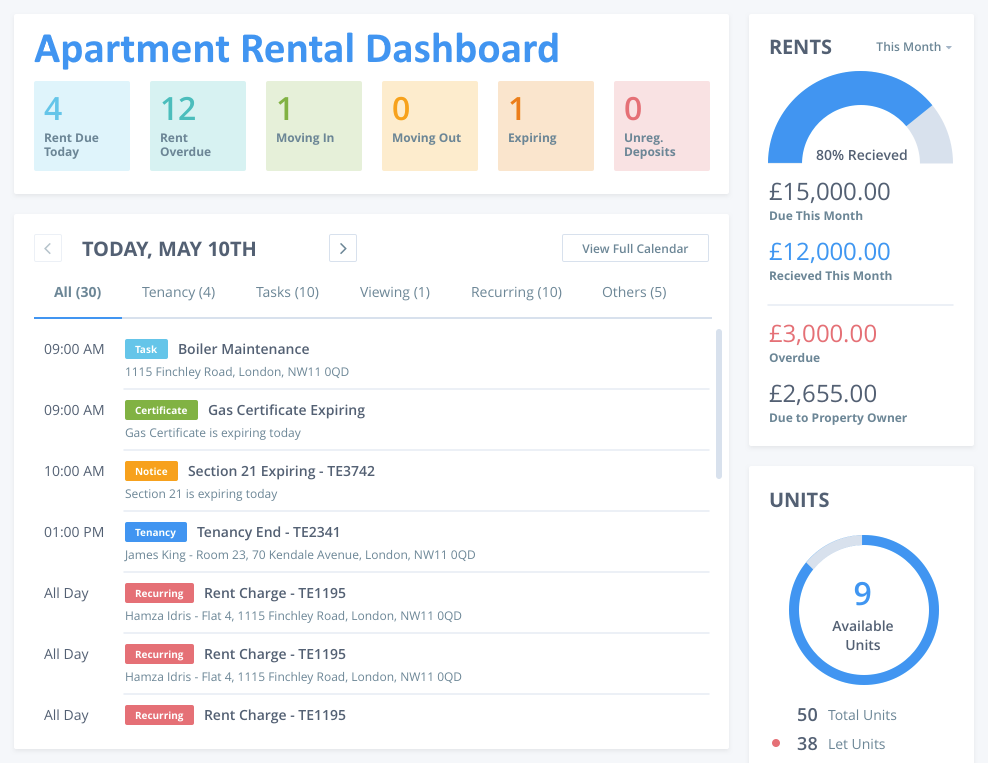Dashboard Reporting Development for Apartment Rental Software
The apartment rental industry is no different than any other industry when it comes to the need for effective data analysis and reporting. With software improvements, property managers and owners now have a more convenient way to keep track of their properties and evaluate their performance. Primarily through the use of dashboard reporting, which can simplify numerous property operations.
With the right dashboard, you can streamline communication with tenants and service providers, as well as automate rent collection and lease renewals. This versatile tool is truly a lifesaver for anyone working in the property management industry. However, how do you create one for a client's specific needs?
In this article, we'll share some key steps to help you create a dashboard reporting in apartment rental software development. From defining your goals and key metrics to implementing must-have features, we'll guide you through the process. Continue reading to learn more.
| #1 Ranking: Read how InetSoft was rated #1 for user adoption in G2's user survey-based index | Read More |
Why Is Dashboard Reporting Important In Apartment Rental Software Development?
Any property management software development company should prioritize incorporating dashboard reporting in their solution because it provides users with:
- A quick overview of properties and their KPIs
- Data visualization
- Real-time monitoring
- Enhanced financial visibility
- Improved decision making
- Efficient performance tracking
- Regular tenant and property insights
What's more, a well-designed dashboard enables individuals and organizations to identify trends, track goals, and make timely, data-driven decisions.
Features of Rental Property Management Dashboard Software
Dashboard reporting has a lot to offer apartment rental professionals. Let's take a closer look at all the key metrics to track in order to make it a valuable asset for property management.
- Property overview. A snapshot of key metrics for each property, including occupancy rates, rental income, maintenance status, and other relevant data.
- Financial management. Charts, graphs, and tables showing financial data such as rent collection, expenses, profits, and budget comparisons.
- Occupancy and availability. Real-time data on the number of occupied apartments, future availability, and lease renewals.
- Tenant information. Brief information about tenant profiles, lease agreements, and communication history.
- Rent collection status. Count of renters who are due, overdue, moving in, moving out, expired, deposits due.
- Asset management. Inventory of property assets, including appliances, fixtures, and furniture.
- Maintenance data. Tracking the property's condition, repairs, and scheduled maintenance.
- Marketing analytics. Comprehensive reports on your marketing efforts, including ad campaign performance, lead generation, and conversion rates.
- Customizable reports. Ability to create individual reports with the data that is most important to you.
Key Dashboard Metrics for Rental Property Management
Property Overview
- Occupancy Rate: Percentage of rented units or square footage.
- Rental Income: Total income generated from rents.
- Property Valuation: Current market value of the property.
- Total Number of Properties: The count of properties in the portfolio.
Financial Performance
- Net Operating Income (NOI): Total income minus total operating expenses.
- Return on Investment (ROI): Percentage return on the property investment.
- Debt Service Coverage Ratio (DSCR): Ability to cover debt payments with income.
Tenant Management
- Tenant Turnover Rate: Percentage of tenants leaving within a specified period.
- Arrears Ratio: Percentage of rent payments overdue.
- Tenant Satisfaction Scores: Feedback from tenant surveys.
Maintenance and Repairs
- Average Time to Resolve Maintenance Requests: Time taken to address maintenance issues.
- Maintenance Cost Ratio: Percentage of income spent on maintenance.
Lease Management
- Lease Expiry and Renewal Rates: Number of leases expiring and renewal rates.
- Average Lease Duration: Average length of tenant leases.
Compliance and Risk Management
- Regulatory Compliance Status: Adherence to local laws and regulations.
- Risk Assessment Scores: Evaluation of potential risks and mitigation strategies.
Market and Asset Trends
- Property Appreciation Rates: Percentage increase in property values.
- Market Rent Comparison: Comparison of property rents with market averages.
 |
View live interactive examples in InetSoft's dashboard and visualization gallery. |
Best Practices for Devloping Effective Property Management Dashboards
To make an effective data dashboard, it is crucial to have a well-defined strategy in place. Fortunately, you can create one using the best practices we've prepared.
1. Know Your Users - Dashboard reporting works differently across industries, departments, and teams. While some people demand hard numbers and in-depth analytics, others prefer to see trends and progress toward their goals. Learn about your user's needs and strive to deliver the best results.
2. Select Relevant KPIs - We've listed all the possible KPIs above.
3. Define Objectives - Clearly define the purpose of your dashboard. Is it for property owners, investors, or property managers? What specific insights are you aiming to deliver?
4. Identify Key Stakeholders - Identify the primary users of the dashboard: property owners, investors, property managers, or other relevant parties.
5. Choose a Dashboard Tool -Choose a dashboard tool that aligns with your goals and is user-friendly. Tools like InetSoft can be considered.
6. Data Integration - Integrate data from relevant sources such as property management software, financial systems, and other databases.
7. Dashboard Design - Organize the dashboard with a clean and intuitive layout.
8. Customizable Views - Allow users to customize their charts based on their preferences.
9. Visualization Techniques - Use visualizations like bar charts, line graphs, scatter plots, and heatmaps: Highlight areas that need attention, such as high arrears or low occupancy.
10. Interactivity - Allow users to drill down via filters or selection lists into specific details for a more detailed view.
11. Mobile Responsiveness -Ensure the dashboard is accessible and functional on various devices, including mobile.
12. Continuous Monitoring and Improvement - Collect feedback from users for continuous improvement.
13. Regular Updates - Get something into production quickly and then eep the dashboard updated with the latest suggestions.

